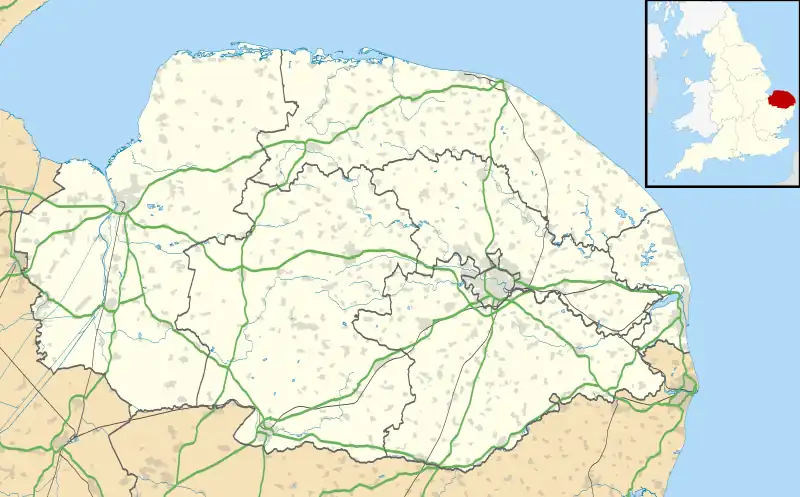| Denver | |
|---|---|
 St Mary's Church, Denver | |
 Denver Location within Norfolk | |
| Area | 10.61 km2 (4.10 sq mi) |
| Population | 890 (2011 census) |
| • Density | 84/km2 (220/sq mi) |
| OS grid reference | TF613016 |
| Civil parish |
|
| District | |
| Shire county | |
| Region | |
| Country | England |
| Sovereign state | United Kingdom |
| Post town | DOWNHAM MARKET |
| Postcode district | PE38 |
| Police | Norfolk |
| Fire | Norfolk |
| Ambulance | East of England |
| UK Parliament | |
Denver is a village and civil parish in the English county of Norfolk. The village is situated on the River Great Ouse, approximately 1 mile (1.6 km) south of the small town of Downham Market, 14 miles (23 km) south of the larger town of King's Lynn, and 37 miles (60 km) west of the city of Norwich.[1][2]
History
Denver's name is of Anglo-Saxon origin and derives from the Old English for a passage or crossing used by the Danes.[3]
Denver acted as the terminus for the Roman road, the Fen Causeway which began in Peterborough.
In the Domesday Book, Denver is listed as a settlement of 43 households in the hundred of Clackclose. In 1086, the village was part of the estates of William de Warenne.[4]
Denver Sluice controls the water levels between the tidal and non-tidal Great Ouse. In 1651, the first sluice to help with the drainage of The Fens was built by the Dutch architect Cornelius Vermuyden. The sluice was rebuilt after bursting in 1713. John Rennie the Younger built a sluice and bridge in 1834. It was enlarged in 1923 and the flood gates have been replaced several times.The four-arched bridge has its piers extended to form two locks. It is Grade II listed.[5] The West Norfolk Rowing Club is based at Denver Sluice.

Denver Windmill was built in the mid-nineteenth century and today is fully restored.
Denver Railway Station opened in 1847 as a stop on the Great Eastern Railway between King's Lynn and Cambridge. The station was closed to passengers in 1930.

Geography
According to the 2011 Census, Denver is a settlement of 890 residents living in 379 households.[6]
Denver falls within the constituency of South West Norfolk and is represented in Parliament by Liz Truss of the Conservative Party.
St Mary's Church
Denver's parish church is of Norman origin and is dedicated to Saint Mary. The church was heavily remodelled in the later nineteenth century with the stained glass being created and installed by Ian Pace.[7] The church is Grade II listed and holds regular church services.
Famous residents
George William Manby, English author and inventor
In popular culture
In the novels of Dorothy L. Sayers, the fictional Duke of Denver's family seat is supposedly based on the village.
War memorial
Denver shares a war memorial with the nearby villages of Fordham, Ryston and Bexwell located on the village green taking the form of hexagonal stone column topped with a crucifix. The memorial lists the following names for Denver for the First World War:

- Stoker-First Class G. Beck (1890-1916), HMS Queen Mary
- Stoker-First Class Harry Paul (1893-1916), HMS Queen Mary
- Quarter-Master-Sergeant Frederick Armsby (1872-1917), 8th Battalion, Royal Norfolk Regiment
- Sergeant W. Dack (1878-1919), Y Company, Royal Army Service Corps
- Sergeant George R. Day (d.1914), 1st Battalion, Royal Norfolk Regiment
- Sergeant Arthur Day (d.1914), 2nd Battalion, King's Royal Rifle Corps
- Corporal William Hassack DCM (d.1916), 6th (City of London) Battalion, London Regiment
- Lance-Corporal Charles H. Holliday (d.1916), Coldstream Guards
- Lance-Corporal Reginald P. H. Howlett (d.1918), 1st Battalion, Royal West Kent Regiment
- Lance-Corporal E. Scarborough (d.1917), 9th Battalion, Royal Norfolk Regiment
- Private John Garrod (d.1917), 6th Battalion, Border Regiment
- Private Arthur Hilling (1895-1916), 1st Battalion, Coldstream Guards
- Private John W. Hall (d.1918), 1st Battalion, Essex Regiment
- Private Ernest R. B. Chapman (1897-1917), Royal West Kent Regiment
- Private James W. Rodwell (1895-1918), 2/6th Battalion, Manchester Regiment
- Private Robert Fountain (d.1915), 2nd Battalion, Royal Norfolk Regiment
- Private Horace Allcock (1897-1917), 3rd Battalion, Royal Norfolk Regiment
- Private Harold Monk (1895-1914), 1/5th Battalion, Royal Norfolk Regiment
- Private Francis H. Holliday (1885-1916), 8th Battalion, Royal Norfolk Regiment
- Private H. Hurrell (d.1919), 2nd Garrison Battalion, Suffolk Regiment
- Private William E. Fendick (1873-1915), 2nd Battalion, Suffolk Regiment
- Private Horace Sutlefe (d.1917), 9th Battalion, Royal Welch Fusiliers
- Private Thomas Redcar (1899-1918), 1st Battalion, Wiltshire Regiment
- Private William H. Holliday (d.1918), 1st Battalion, Yorkshire Regiment
- Private George Akred (1897-1917), 1/4th Battalion, East Yorkshire Regiment
References
- ↑ Ordnance Survey (1999). OS Explorer Map 236 - King's Lynn, Downham Market & Swaffham. ISBN 0-319-21867-8.
- ↑ Ordnance Survey (1999). OS Explorer Map 228 - March & Ely. ISBN 0-319-21860-0.
- ↑ University of Nottingham. (2022). Retrieved 22 December 2022. http://kepn.nottingham.ac.uk/map/place/Norfolk/Denver
- ↑ Domesday Book. (1086). Retrieved 12 December 2022. https://opendomesday.org/place/TF6101/denver/
- ↑ Historic England. "Denver Sluice (Grade II) (1077851)". National Heritage List for England.
- ↑ Office for National Statistics. (2011). Retrieved 22 December 2022. https://www.nomisweb.co.uk/reports/localarea?compare=E04006301
- ↑ Knott, S. (2005). Retrieved 22 December 2022. http://www.norfolkchurches.co.uk/denver/denver.htm
